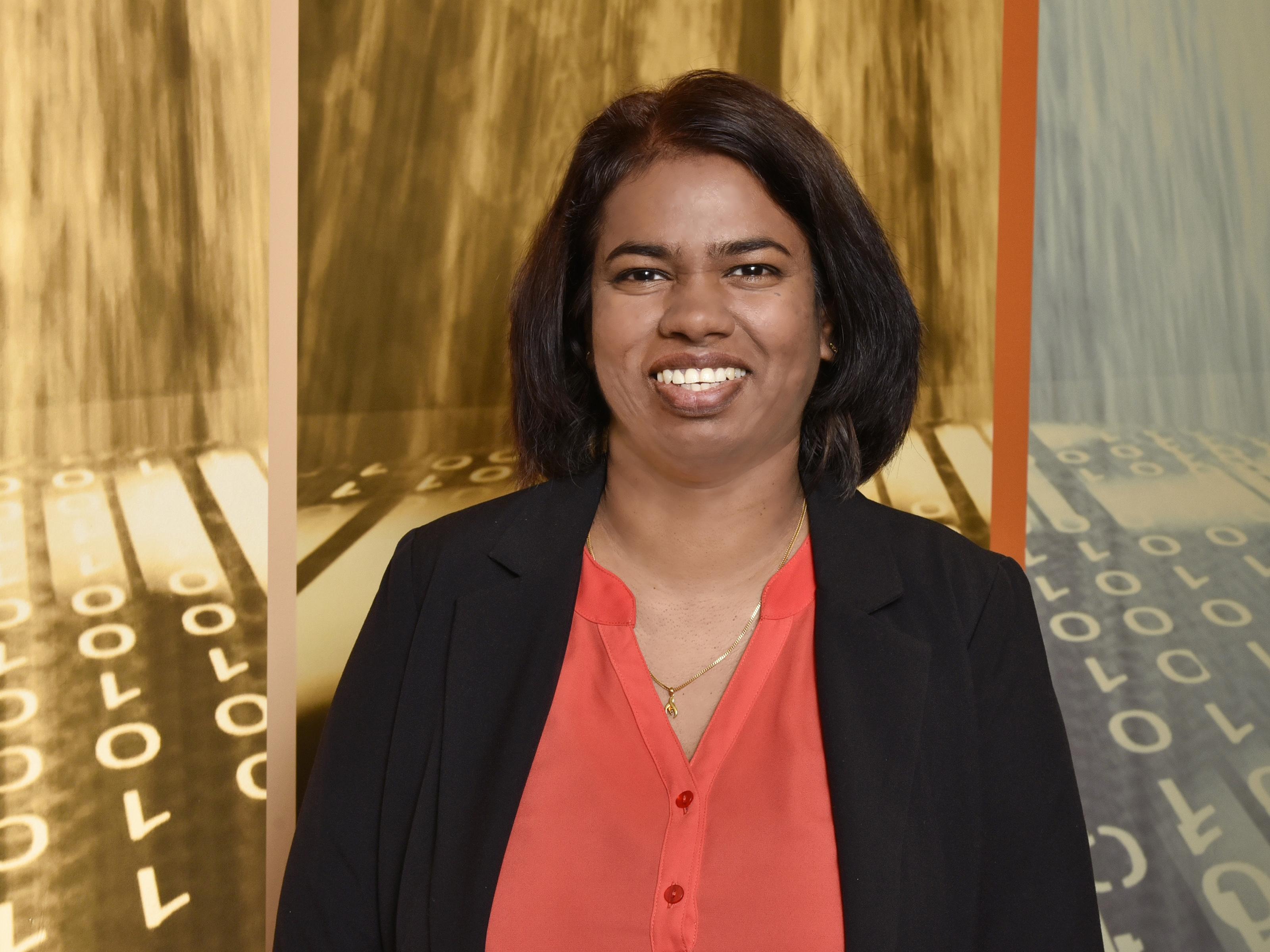Indu Rasika Churchill of the SUNY Oswego mathematics faculty recently earned the Provost’s Award for Scholarly and Creative Activity, which recognizes a junior faculty member, in this case a “rising star” in the words of her nominator.
“We have a brilliant rising star among us, a woman in a field dominated by men, living and working through a pandemic, and churning out mathematical publications faster than the rest of the entire department combined,” wrote Churchill’s nominator and mathematics faculty colleague Elizabeth Wilcox. “‘Inspiration’ is not strong enough to cover the depth of the emotion I feel when reading Rasika’s CV.”
Churchill joined Oswego’s faculty in 2017, and Wilcox noted: “In her short time at SUNY Oswego, Rasika has established herself as an impressive researcher, a deft mentor of student scholars, and a supportive and energetic colleague – one who richly deserves recognition for being a powerhouse of mathematical results.”
Wilcox called Churchill “a pioneer in the field of singquandles” and “an expert in both knot theory and quandles.”
“Knot theory is at the intersection of topology and abstract algebra in mathematics, with a lean towards the topological viewpoint,” Wilcox explained. “There are some applications of knot theory to real-world problems in protein folding and DNA strand formation but in general, mathematical knot theory greatly simplifies these complex biological and chemical processes.”
Mathematicians like Churchill study knots for their intrinsic value as knots while developing a deeper understanding of abstract links between knots and other mathematical areas, Wilcox noted, as singular knots are connected to quantum algebra.
“Quandles are algebraic structures that are related to knots, so new on the scene that the vocabulary for the area has only been made uniform in the 1980s,” Wilcox wrote. “Quandles capture many of the important properties of knots in an algebraic setting, and singquandles are used to study singular knots. This type of quandle was introduced only in the recent past and the study of singquandles is rapidly developing, in large part due the driving forces of Rasika and her collaborators.”
Productive researcher
In five years with SUNY Oswego, Churchill has had 10 manuscripts accepted for publication, which Wilcox said is exceedingly productive for the field.
In “keeping pace with nationally acclaimed stellar mathematicians,” Wilcox noted, “Rasika does not sacrifice quality for quantity in terms of publications. Rasika and her collaborators are making significant headway in developing ways to study and understand new structures, producing not only novel results but also summarizing those results in surveys so that other mathematicians can keep up with new developments and join in on their work.”
Her expertise has drawn the attention of The Journal of Knot Theory and Its Ramifications, and she has published multiple articles in this top specialist journal on the topic that connects this theory with other aspects of mathematics and natural sciences.
Churchill regularly involves students in her projects, including Nicolas van Kempen and Navya Amaratunga on Research Fund for Chemistry and Math/Science Students Awards, as well as several others on capstone projects and independent studies in topology and knot theory. Churchill and van Kempen co-authored a publication stemming from a summer research project.
Wilcox has “witnessed firsthand how Rasika approached working with a student: as equals,” she wrote. “Rasika treated Nicolas as a collaborator, never dumbing down the mathematics or the expectations, but explaining concepts and working with Nicolas to reach a deeper shared understanding of the project’s concepts.”
Churchill actively looks for students who might have a background and interest in both science and mathematics as potential research collaborators, Wilcox added.
As a Ph.D. student at the University of South Florida, Churchill was “one of the best students I ever had,” wrote Mohamed Elhamdadi of USF’s Department of Mathematics and Statistics, who has continued working with her on research since she joined SUNY Oswego. “Rasika's work is impressive because what she has done is take one branch of mathematics and interject it into another branch of mathematics. She's not just completely focused on one particular concept but rather has an impressive overarching skill set.”
“Rasika is an amazing scholar with incredible ideas,” wrote another research collaborator, Jose Ceniceros of Hamilton College’s math faculty. “Rasika is an inspiration for mathematicians from underrepresented groups like myself. I have been amazed at the level of care and thoughtfulness that Rasika approaches each project. I look forward to collaborating with Rasika for many years to come.”
Churchill earned her Ph.D. in pure and applied mathematics and a master’s in mathematics from the University of South Florida, and a B.Sc. Special (first class honors) in mathematics from University of Kelaniya in Sri Lanka.




